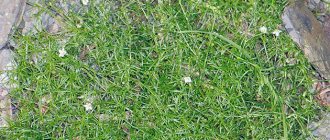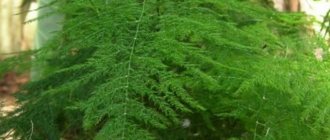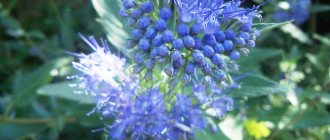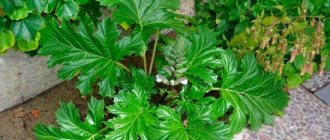Holly, or holly, is an evergreen, less often a deciduous shrub or tree up to 15 m high, valued in culture for its beautiful shiny leaves and decorative yellow or red fruits. Holly leaves are bright, shiny, with a wavy edge and large prickly teeth. Fragrant white flowers. The fruits are spherical, up to 1 cm in diameter, yellow or red, and remain on the plant throughout the winter.
There are about 300 species in the genus, distributed in Europe, Japan, China, Africa and America. The most popular is the common holly, or holly.
Common holly, or holly, common holly, Ilex aquifolium
An evergreen shrub, less often a tree with a dense pyramidal or oblong crown. The bark of the tree is gray, smooth. The leaves are on short petioles, oblong-ovate, up to 7 cm long, dark green above, light green below. It blooms in May–June with white small fragrant flowers. The plant is dioecious. To bear fruit you need to have at least two, or preferably three, plants.
Red, shiny fruits decorate the bush all winter.
Holly or holly BERRIES are dangerous!
There are numerous forms, differing in crown shape, leaf color and shape, and fruit color.
Common holly is heat-loving: USDA zone 6-7. In the Moscow region and the middle zone, it winters only with the root zone covered and there is still a danger of freezing and death of the bush.
Compact varieties of common holly can be grown in a container year-round. In the summer, place the pot with the plant in the garden, and put it in the greenhouse for the winter.
Common holly Argentea Marginata
Common holly variety Alaska, or Alaska holly
We are very interested in the holly cultivar with the characteristic name Alaska. It is a slow-growing shrub with a narrow, compact crown and small, sharp-toothed, dark green leaves. In the presence of a pollinator (varieties Blue Prince, Casanova), it produces many bright red fruits in the fall. But, most importantly, Alaska holly is considered the hardiest variety, and more winter-hardy than the main species. But shelter is still necessary early on, although for the variety the winter hardiness zone in the reference books is indicated as 4, i.e. to -29.
Common holly variety Alaska, holly Alaska
Common holly variety Rubricaulis Aurea
Another variety that you should pay special attention to is the most winter-hardy variety of variegated holly. The bushes are wide, cone-shaped, by the age of 10 they grow up to 2 m high. The shoots are very violet-brown, the leaves are jagged, round, 5-6 cm long, dark green with a yellow border. It blooms in May-June, and bears fruit abundantly in the fall in the presence of the pollinator variety Blue Prince, no more than 5 m away.
Medicinal properties
The plant not only has a beautiful appearance, but also has medicinal properties. Holly leaves are used to treat heart diseases, as well as colds and kidney diseases. It is often recommended to brew holly to combat rheumatism, dropsy and arthritis.
To prepare the infusion, you will need to spend a minimum amount of time. Follow the steps:
- Pour a couple of tablespoons of plant leaves into a glass of vodka.
- Transfer the liquid to a dark place and leave for a week.
- Strain, dilute with water and take 20 drops orally twice or thrice a day on an empty stomach.
Holly holly is a beautiful plant that adorns many garden plots. It is used both to create a unique design and for medicinal purposes. Since it requires virtually no care, the plant continues to win more and more hearts of gardeners.
Meserve's Holly, Ilex x meserveae
Meserve's holly is a hybrid of the common and rugose hollies. Great new product! Because withstands frosts near Moscow!
Meserve holly varieties
Holly Meserve Blue Princess, Blue Princess
Female form, evergreen, slow-growing shrub up to 3 m high. The variety bears fruit in the presence of a pollinator, for example, the Blue Prince variety.
The fruits are bright red, the leaves are glossy, prickly, dark green. The variety is winter-hardy if there is light winter shelter.
Holly or holly is perfect for planting in hedges and for single plantings.
First steps after purchase
Buying Holly for bonsai requires patience, which will be required as it is a slow-growing plant. In addition, you need to imagine what you plan to get in the end. Finally, you should immediately choose a suitable place for the plant. In summer, this could be a balcony, terrace or patio. In winter, it is advisable to move the Holly to a cool, draft-free room. Species growing in tropical areas are best kept indoors, providing them with regular watering and spraying.
Features of planting and growing holly
Place to plant holly
Holly can be planted in the sun, but it is better in partial shade, in a place protected from the wind. Soils are preferably moderately acidic and moist.
How to preserve holly in winter?
For the winter, it is necessary to cover the holly root zone and protect it from sunburn in the spring. Hollies overwinter best in the shade with well-covered roots.
Is it possible to prune holly or holly?
YES! This shrub lends itself well to shaping and pruning.
Can you grow holly at home?
Yes! Compact holly varieties can be grown as potted plants. We remember the main thing: it loves shade, in winter - a bright and cool place, a window sill is just right. In summer, it’s best to find a place for it in the garden, in the shade.
Watering is constant, but moderate. The plant does not like to dry out, but there is no need to overwater it.
The pot is large, with drainage and drainage holes. The soil is fertile. Replanting - once every 2-3 years, as the bush grows.
Fertilizing - during the growing season with conventional complex fertilizers once a month.
Systematic care for culture
When the holly tree successfully takes root on the site, careful care begins. It includes a number of activities:
- loosening the soil;
- watering;
- feeding;
- pruning;
- mulching the root area.
Loosening is carried out as the top layer of soil hardens after watering. It will also be needed if weeds thrive nearby. Young seedlings are moistened 2 times a week, in the absence of regular rainfall.
As you know, the evergreen holly grows rather slowly. Thanks to this, it is convenient to form its crown. Pruning is carried out in early spring, removing frozen and damaged shoots. To create a beautiful landscape, designers organize topiary trimming of plants.
Feed holly in early spring. To do this, compost is mixed with mineral fertilizers. And then they are laid out around the trunk of the bush. Spring rains will do their job, and nutrients will gradually penetrate into the soil.
In late autumn, holly needs additional shelter. It is constructed from fallen leaves or spruce branches. The tree trunk area is insulated with a layer of peat or sawdust.
We met an amazingly beautiful evergreen plant. Its rich green foliage pairs harmoniously with snow-white flowers in spring and bright berries in summer. We examined how proper planting and care of holly is carried out in different climatic zones. The plant develops wonderfully in both southern and northern regions (only frost-resistant varieties). It is also grown in the Moscow region. Let this plant, shrouded in mystery, decorate another area of our beautiful planet.
Holly in New Year's floristry, and not only in New Year's
Holly leaves and berries are actively used in floristry. When working with the leaves of this plant, you must be careful, as they have pointed ends that can cause injury. One side of the hard sheet is glossy, the other is matte; contrasting compositions are often built on this difference. Berries can be used in decorative compositions. Holly shoots are very persistent and good for Christmas and New Year's arrangements.
Holly branches can be kept in a vase for 2 weeks. Before planting, trim the holly branches with pruning shears and pour water at room temperature.
Holly in a floral composition
Christmas symbol
Thanks to its vitality and sharp leaves, holly has long been considered a plant - a talisman. Irish cattle breeders used it to make pens for animals. The branches were used to decorate homes to drive out evil spirits. The Romans dedicated holly branches to Saturn and used the plant during the winter Saturnalia celebrations. At this time, it was customary to decorate houses with entire garlands of holly, invoking spring, fertility and good luck.
The Celts attributed magical properties to holly. Wreaths were woven from it and used in rituals. Ancient healers used the berries, leaves and roots of holly as a diuretic, emetic, antipyretic and laxative.
Paraguayan holly leaves, rich in caffeine, are brewed as an exotic tea. An original tonic drink made from dried and roasted fruits can replace coffee and has its admirers to this day. The plant became a symbol of Christmas and New Year holidays much later. The first Christians associated the sharp leaves of holly with the Savior's crown of thorns, and the scarlet berries with drops of his blood.
Thus, the plant simultaneously symbolizes the suffering of Jesus Christ, his resurrection and eternal life. The Christmas plant with red berries is called “holly” in Europe and America. Moreover, it is only consonant with the English word “saint”. The Indo-European roots of the name come from the concept of “prickly”. In Europe, holly is the same symbol of the New Year as the Christmas tree is for Russians.
Its excellent decorative value in winter allows the branches with dark green leaves and blood-red berries to be used as a Christmas decoration for the home. Recognizable leaves and fruit beads are present on greeting cards, posters, and banners. The British traditionally decorate their Christmas pudding with a sprig of holly. In addition to its protective properties, modern signs about holly have added the ability to bring good luck in money matters.
History and legends of holly or holly
In ancient Rome, holly was sacred to Saturn and was used during the Saturnalia as a symbol of health and happiness. Holly, like oak, were sacred trees of the Druids.
According to an ancient custom, holly planted near a house protects against hostile influences. Holly branches attached to the entrance will prevent evil spirits from entering the house.
In England and America, a couple of trees are always planted - a male and a female - so that berries will form, since holly, which does not have berries, is believed to bring bad luck to the owner.
Reproduction of mahonia holly by cuttings, seeds and layering
There are several effective ways in which mahonia holly is bred - propagation by cuttings, sowing seeds and the formation of layering. Each gardener chooses the most suitable, convenient option for himself. Most people prefer propagation by cuttings for mahonia - the technology is simple, effective, and does not involve complex manipulations.
How mahonia holly is propagated by cuttings is described below - read the key points of the procedure:
- In early spring, lignified shoots are cut and all leaves are removed.
- The cuttings are placed in a container with water (only 2-3 buds are left above the surface of the liquid).
- The vessel is sent to fresh air, but protected from bright rays.
- When, after a few months, the length of the roots on the shoots reaches a length of 5 cm, the cuttings can be planted in open soil, covered after planting with a glass jar or a transparent plastic bottle.
- After 10 days, they begin to harden the plant, raising the cover more and more every day.
Growing cuttings of mahonia holly allows you to obtain a specimen that completely repeats the biological characteristics of the mother bush.
No less often than cuttings, another method of spreading mahonia holly is used - propagation by sowing seeds purchased in a store for summer residents or obtained independently from the fruits of the plant that have ripened in the fall. If you plant grains immediately after harvesting, they will undergo natural stratification, and by spring they will delight you with young seedlings. The seeds are sent into small holes, deepened by 1-2 cm. Mulching of the sprouts is highly recommended. Gardeners move seedlings that have reached the age of 2 years to a permanent place of “habitat”, where they then provide caring for and cultivation of mahonia according to generally accepted rules.
Mahonia can also be propagated very successfully by layering. For this purpose, the most powerful, healthy branches in the spring are bent close to the ground and placed in a previously prepared oblong hole. The shoot is pinned with a large metal bracket and sprinkled with a layer of fertile soil. The top is left free on the outside.
How mahonia is planted and cared for in this way, look at the photo:
To optimize the rooting process, the bend on the branch is tied with wire. By autumn, the cuttings should take root on their own. Then it can be separated from the mother specimen. This manipulation is postponed until next year if the root apparatus is not strong enough. In the future, favorable conditions are created for the development of mahonia (care and cultivation are closely interrelated activities).
Taxonomy
Main article: Species of the genus Holly
In the genus Holly approx. 475 species. Evergreen and deciduous trees, shrubs and vines, including:
- Ilex affinis Gardner
- Ilex ambigua (Michx.) Torr. — Holly is dubious
- Ilex amelanchier MACurtis ex Chapm.
- Ilex anomala Hook. & Arn.
- Ilex aquifolium L. - Holly holly
- Ilex argentina Lillo
- Ilex arimensis (Loes.) Britton ex ROWilliams
- Ilex asprella (Hook. & Arn.) Champ. ex Benth.
- Ilex bioritensis Hayata
- Ilex brasiliensis (Spreng.) Loes.
- Ilex brevicuspis Reissek
- Ilex buergeri Miq.
- Ilex canariensis Poir.
- Ilex cassine L.
- Ilex centrochinensis SYHu - Central China Holly
- Ilex ciliospinosa Loes.
- Ilex cinerea Champ. ex Benth.
- Ilex colchica Pojark. — Colchis holly
- Ilex collina Alexander
- Ilex cookies Britton & P. Wilson
- Ilex corallina Franch. — Holly coral
- Ilex coriacea (Pursh) Chapm. — Leatherback holly
- Ilex cornuta Lindl. & Paxton - Horned Holly
- Ilex crenata Thunb. — Holly crenate
- Ilex cuthbertii Small
- Ilex cyrtura Merr.
- Ilex decidua Walter - Deciduous holly
- Ilex delavayi Franch.
- Ilex dimorphophylla Koidz.
- Ilex dipyrena Wall.
- Ilex dumosa Reissek
- Ilex excelsa (Wall.) Hook.f.
- Ilex fargesii Franch. — Holly Fargeza
- Ilex ficoidea Hemsl.
- Ilex forrestii H.F.Comber
- Ilex fragilis Hook.f.
- Ilex geniculata Maxim.
- Ilex georgei HFComber
- Ilex glabra (L.) A.Gray – Naked holly
- Ilex goshiensis Hayata
- Ilex graciliflora Champ. ex Benth.
- Ilex guayusa Loes.
- Ilex guianensis (Aubl.) Kuntze
- Ilex hanceana Maxim.
- Ilex hayataiana Loes.
- Ilex hookeri King
- Ilex hyrcana Pojark. — Hyrcanian holly
- Ilex insignis Hook.f.
- Ilex integerrima (Vell.) Reissek
- Ilex integra Thunb. — Entire holly
- Ilex intricata Hook.f.
- Ilex kaushue SYHu
- Ilex krugiana Loes.
- Ilex laevigata (Pursh) A.Gray – Smooth holly
- Ilex latifolia Thunb. — Holly broadleaf
- Ilex leucoclada (Maxim.) Makino
- Ilex liukiuensis Loes.
- Ilex longipes Chapm. ex Trel.
- Ilex macfadyenii (Walp.) Rehder
- Ilex macrocarpa Oliv. — Large-fruited holly
- Ilex macropoda Miq.
- Ilex memecylifolia Champ. ex Benth.
- Ilex micrococca Maxim.
- Ilex mitis (L.) Radlk.
- Ilex montana Torr. & A.Gray – Mountain Holly
- Ilex mucronata (L.) M. Powell, Savol. & S.Andrews
- Ilex myrtifolia Walter
- Ilex nipponica Makino
- Ilex nothofagacifolia Kingdon-Ward
- Ilex opaca Aiton - Matte Holly, or Dull Holly
- Ilex paraguariensis A.St.-Hil. — Paraguayan holly
- Ilex pedunculosa Miq. — Holly pedicel
- Ilex perado Aiton - Perado holly, or Canarian holly
- Ilex pernyi Franch. — Holly of Pern
- Ilex pubescens Hook. & Arn.
- Ilex purpurea Hassk.
- Ilex rockii SYHu
- Ilex rotunda Thunb. — Holly round
- Ilex rubra S.Watson
- Ilex rugosa F.Schmidt - Wrinkled holly
- Ilex scopulorum Humb. &Bonpl. ex Schult. & Schult.f.
- Ilex serrata Thunb. — Serrated holly
- Ilex sideroxyloides (Sw.) Griseb.
- Ilex sikkimensis Kurz
- Ilex sintenisii (Urb.) Britton
- Ilex sugerokii Maxim. — Holly Sugeroki
- Ilex szechuanensis Loes.
- Ilex theezans Reissek
- Ilex tutcheri Merr.
- Ilex venulosa Hook.f.
- Ilex verticillata (L.) A.Gray - Whorled holly
- Ilex viridis Champ. ex Benth.
- Ilex vomitoria Sol. ex Aiton
- Ilex warburgii Loes.
- Ilex wightiana Wall. ex-Wight
- Ilex wilsonii Loes.
- Ilex yunnanensis Franch. — Yunnan holly
Interesting Facts
- Holly King and Oak King are characters from English folklore, eternal opponents, each of whom owns half the year.
- In J. K. Rowling's Harry Potter series, Harry's wand was made of holly with a phoenix feather core.
- The name Hollywood literally means “holly grove” or “holly grove”.
- The name of the area Eregion in Middle-earth (in the works of J. R. R. Tolkien) comes from the Sindarin name for holly, sometimes translated into Russian as Ostranna or Holly. At the gates to Moria there were two giant holly trees. In a previous era, when the evil will of Sauron had not yet ravaged Eregion and expelled the dwarves of the Longbeard clan (the people of Durin), tall hollies grew along the road that connected their kingdoms, Eregion and Khazad-Dum.











